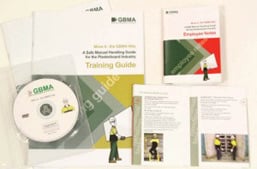
When it comes to training staff on safety or procedures, one of the biggest problems many of our clients talk about is the difficulty of training staff consistently...
 Companies often tell us that they are frustrated by how hard it is to engage staff with training.
Companies often tell us that they are frustrated by how hard it is to engage staff with training.
After a bit of digging, we usually find out that training consists of:
What research has found is that is that passive/low engagement training is ineffective compared to active/high engagement training. Passive training is when you get a trainer or lecturer telling lots of information or when lots of reading is involved.
The most engaging methods of safetytraining are, on average, approximately three times more effectivethan the least engaging methods in promoting knowledge and skillacquisition, as well as reducing accidents,illnesses, and injuries.
So any training that is designed around a trainer reading through slides is not enough to create engagement. Nor is producing a training manual and expecting workers to read it.
Educational researchers have found that 83% of human learning occurs visually. The right brain prefers visuals and can process pictures hundreds of times faster than words.
When it comes to producing training materials, it's a good idea to use as many visuals as you can. And to really increase engagement, try and get trainees to touch, see and hear (obviously, taste and smell aren't suitable to all industries, but they work especially well in food). Use as many of the senses as you can during training.
And while having a trainer talking at students is passive training including lots of "Show and Tell" or demonstrations takes the training to a new level. This is where the trainer demonstrates a process and gets the trainee to have a go. This is integral to an active learning style. Coaching is then given to improve. Which brings us to assessment, which is also really important with learning. It is important that trainees get face to face feedback on how to improve rather than information from a computer.
 To make use of this powerful memory booster, training materials need to be centred around a visually appealing training video. By getting learners to see, listen and read important information you start getting higher levels of recall than just reading alone. After all, we remember 10% of what we read, 20% of what we hear and 30% of what we see, so by addressing these three areas, recall is increased to 60% v 10% for reading alone.
To make use of this powerful memory booster, training materials need to be centred around a visually appealing training video. By getting learners to see, listen and read important information you start getting higher levels of recall than just reading alone. After all, we remember 10% of what we read, 20% of what we hear and 30% of what we see, so by addressing these three areas, recall is increased to 60% v 10% for reading alone.But just having a training video is not enough. Another important addition to your training kit is the Trainer's Manual. This guide needs to help the trainer know the best method to teach the material. It needs to include a trainer's session schedule that has advice on what segments of the training video to play, what questions to discuss, when to do a demonstration, when to get trainees to have a go, when to pass around relevant items and the questions and answers for the quiz (and how to test respondents and discuss the answers).
In addition, to really keep trainees engaged and to help them believe that the training is important, each trainee needs to receive their own copy of an Employee Handbook. This is the document that they go through in class, it needs to have information on how to undertake tasks, as well as photos that will remind them of the training video that they have seen. The booklet needs to also contain their quiz with space for them to write in their answers (also gives them ownership rights).
By using these three main training materials, you end up with a self-contained training package that gives trainers the resources and support that they need to create an interactive and high engagement training session. It will also ensure that training is taught consistently across numerous locations.


When it comes to training staff on safety or procedures, one of the biggest problems many of our clients talk about is the difficulty of training staff consistently...

Many companies often get frustrated about how their workplace training is inconsistent from site to site, despite trainers using the same training materials.